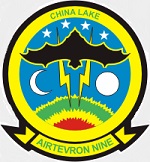Hobby Master HA5154 US Navy Boeing E/A-18G Growler Electronic Warfare Aircraft - 166856, VX-9 "Vampires", Naval Air Weapons Station China Lake, California, 2008 (1:72 Scale)
"The tip of the she spear"
- Motto of VAQ-131 "The Lancers"
 The Boeing EA-18G Growler is an American carrier-based electronic warfare aircraft, a specialized version of the two-seat F/A-18F Super Hornet. The EA-18G replaced the Northrop Grumman EA-6B Prowlers in service with the United States Navy. The Growler's electronic warfare capability is primarily provided by Northrop Grumman. The EA-18G began production in 2007 and entered operational service with the US Navy in late 2009. Australia has also purchased twelve EA-18Gs, which entered service with the Royal Australian Air Force in 2017.
The Boeing EA-18G Growler is an American carrier-based electronic warfare aircraft, a specialized version of the two-seat F/A-18F Super Hornet. The EA-18G replaced the Northrop Grumman EA-6B Prowlers in service with the United States Navy. The Growler's electronic warfare capability is primarily provided by Northrop Grumman. The EA-18G began production in 2007 and entered operational service with the US Navy in late 2009. Australia has also purchased twelve EA-18Gs, which entered service with the Royal Australian Air Force in 2017.
On November 15th, 2001, Boeing successfully completed an initial flight demonstration of F/A-18F "F-1" fitted with the ALQ-99 electronic warfare system to serve as the EA-18 Airborne Electronic Attack (AEA) concept aircraft. In December 2003, the US Navy awarded a development contract for the EA-18G to Boeing. As primary contractor, Boeing was to construct the forward fuselage, wings and perform the final assembly. Northrop Grumman was the principal air frame subcontractor and they would supply the center and aft fuselage as well as the principal electronic combat system. In 2003, the Navy expected to receive 90 EA-18Gs.
The first EA-18G test aircraft entered production on October 22nd, 2004. The first test aircraft, known as EA-1, was rolled out on August 3rd, 2006, before making its maiden flight at St. Louis on August 15th, 2006; it was later ferried to Naval Air Station Patuxent River, Maryland on 22 September 2006. EA-1 primarily supports ground testing in the Air Combat Environment Test and Evaluation Facility (ACETEF) anechoic chamber.
The second aircraft (EA-2) first flew on November 10th, 2006, and was delivered to NAS Patuxent River on November 29th, 2006. EA-2 is an AEA flight test aircraft, initially flying on Pax River's Atlantic Test Range (ATR) for developmental test of the AEA system before transitioning to the Electronic Combat Range (ECR, or 'Echo Range') in Naval Air Weapons Station China Lake in California. Both aircraft are assigned to VX-23 "Salty Dogs". EA-1 and EA-2 are F/A-18Fs F-134 and F-135, pulled from the St. Louis production line and modified by Boeing to the EA-18G configuration. However, since they were not built initially as Growlers, the Navy has designated these two test aircraft as NEA-18Gs. There were five Growlers flying in the flight test program as of June 2008
Pictured here is a gorgeous 1:72 scale diecast replica of a US Navy Boeing E/A-18G Growler Electronic Warfare Aircraft that was attached to VX-9 "Vampires", then deployed to Naval Air Weapons Station China Lake, California, during 2008.
Sold Out!
Dimensions:
Wingspan: 7-1/2-inches
Length: 9-inches
Release Date: September 2022
 Historical Account: "Vampires" - Air Test and Evaluation Squadron Nine (AIRTEVRON NINE, VX-9, nicknamed The Vampires) is a United States Navy air test and evaluation squadron based at Naval Air Weapons Station China Lake, California. Using the tail code XE, the squadron operates numerous aircraft and helicopters of the United States Navy and United States Marine Corps.
Historical Account: "Vampires" - Air Test and Evaluation Squadron Nine (AIRTEVRON NINE, VX-9, nicknamed The Vampires) is a United States Navy air test and evaluation squadron based at Naval Air Weapons Station China Lake, California. Using the tail code XE, the squadron operates numerous aircraft and helicopters of the United States Navy and United States Marine Corps.
Today, VX-9 has approximately 61 officers, 290 enlisted personnel, and 25 aircraft at NAS China Lake including: the F/A-18E/F Super Hornet, EA-18G Growler, F/A-18C/D Hornet, UH-1Y Venom, AH-1W SuperCobra and AH-1Z Viper. Additionally, VX-9 performs operational test on the EA-6B Prowler and AV-8B Harrier II; however, these test assets are owned by VX-23 and VX-31, respectively.
Until the retirement of the F-14 Tomcat, the unit also had 4 F-14As, 3 F-14Bs and 4 F-14Ds at NAS Point Mugu. Although the Point Mugu detachment has ceased operations, a new VX-9 detachment has since been established at Edwards AFB, California for the F-35C Lightning II.
Typically, aircrews are qualified in more than one of these aircraft types which increases their versatility and provides a broader base of expertise that can be applied to each project. VX-9's mission has grown to include the operational evaluation of attack, fighter, and electronic warfare aircraft, weapons systems and equipment, and to develop tactical procedures for their employment.
As for chain of command, operationally, VX-9 reports to Commander, Operational Test and Evaluation Force (COMOPTEVFOR) and administratively to Commander, U.S. Naval Air Force, Pacific Fleet (COMNAVAIRPAC).


